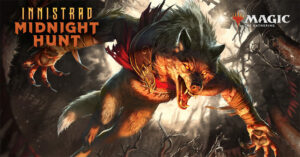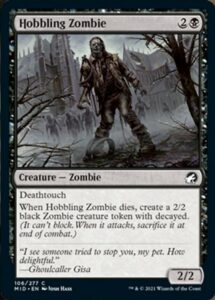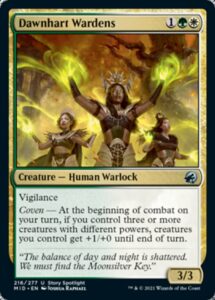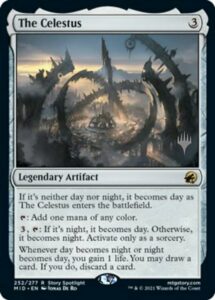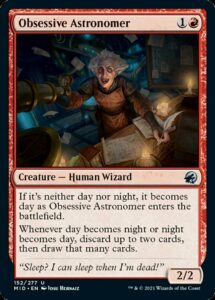With Innistrad: Crimson Hunt spoiler season beginning next week, 2021 will have five Standard expansions. This is a temporary scheduling hiccup as Magic shifts the annual summer Standard set to the late fall, but it leaves us with a lot of new mechanics to review. So, we’re going to do just that. Every new named mechanic from 2021 gets its turn in the spotlight.
All mechanics are not created equally. Some like Flashback have vast design space, making them easy to reuse and remix again and again, while also encouraging Wizards to refrain from using too many innovations at once. Others like Gatecrash’s Cipher consume almost all their design space in a single set. Mark Rosewater does an excellent job of detailing the criteria by which mechanics are measured internally in his Storm Scale series.
Our analysis will lack Wizards’ incredible trove of data and be far more subjective. We’ll also apply some of our metrics, which will be most relevant when considering Adventures in the Forgotten Realms’ additions. With that preamble complete, let’s start working our way backwards.
Innistrad: Midnight Hunt
This set introduced Daybound (and Nightbound), Day/Night, Coven, Disturb, and Decayed. Five is generally the maximum number of new mechanics we’ll ever see in a set, and when do, it’s usually a faction set with fairly simple mechanics.
In addition, Midnight Hunt brought back Flashback and Investigate. These are two outstanding mechanics, but nothing new. They fall beyond our scope—though it is rather notable that Investigate only shows up on five cards, which seems near the minimum for a mechanic to be keyworded.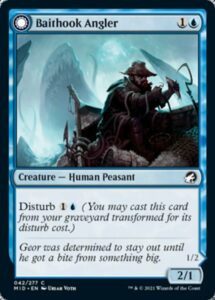
Disturb
Disturb is the latest in a line of mechanics with self-reanimating creatures. Unearth gave a single extra attack. Embalm gave a token copy of a creature. Eternalize provided a modified token copy of a creature. Now, Disturb uses double-faced technology to give you something truly different.
Disturb feels like it should be a slam dunk of a mechanic. It’s relatively simple, has the vital balancing knob of a mana cost, works with a variety of existing effects (most notably, Flickers), tells a story, and feels rewarding. But to me, it’s more serviceable than awesome. Part of this is due to its constrained use—only on twelve cards, and all but one of them are white or blue. If Disturb weren’t in an arguably overstuffed set and instead a core mechanic, we’d obviously see more cards and experimentation.
But I don’t think Disturb can headline a set. It’s a card advantage mechanic, so it being too prevalent or powerful bogs games down. This also is why the backside can look so unappealing, especially for less competitive players—it’s obvious that Galedrifter is much stronger than Waildrifter, but not obvious that Waildrifter is a free card.
I’m also not in love with Disturb’s flavor, which is a shame since Innistrad is a world defined by transformation and death not being final. Disturb tells a clear story—someone dies and becomes a ghostly version of themself. However, I don’t feel the story differs from card to card, though Mourning Patrol and Beloved Beggar‘s stories are outstanding. One could make the same critique of werewolves, but werewolf transformation involves a human becoming more deadly, allows bigger changes in stats, and the human side remains relevant post-transformation. Disturb creatures start and end homogenized—they’re small creatures that (usually) die into small flying creatures.
While I’m not decrying Disturb, I think it’s more a serviceable mechanic to be used in moderation rather than something awesome. It could be used in a variety of ways in the future, from a similar implementation for the Orzhov Syndicate (it’d work great as a faction mechanic, but double-faced cards seem unlikely in a Ravnica set) to a wildly different implementation (the mechanic is super open-ended, so we could easily see cards like Krosan Beast or Proven Combatant where you get a massive creature instead of a spirit).
The mechanic has very deep theoretical design space, but there’s a limit to how cohesive and balanced the end results can be. I liked playing with it, but I didn’t love it.
Decayed
After that mouthful on Disturb, I’m going to say far less about Decayed. I had my doubts about Decayed. It suggests that the zombies are weak and dying off. It’s an aggressive mechanic that’s out of place in blue-black. And it seems to only cost ~0.25 mana, which suggests a very weak mechanic.
I was wrong. Decayed is awesome.
If anything, Decayed is too powerful. The token being essentially free is fair until you get a single card like Siege Zombie or Larder Zombie. After that, you have a value engine that eventually swarm attacks for lethal damage. The play is almost perfect—a lone zombie is no threat at all and easily dispatched, but watching them slowly accumulate, wearing down your nerve, and ultimately swarming, is what eventually does you in. It’s the perfect implementation of a zombie mechanic and the most coherent we’ve ever seen Innistrad zombies (which had previously been split between anti-synergistic token zombies and creature card-eating skaabs).
Decayed is the rare example of an all-downside mechanic that functions super well. How to properly use the token is an open-ended puzzle with many, many correct solutions (and oodles of backwards compatibility). Perhaps there’ll even be more downside mechanics in the future if Wizards can rebottle this lightning in a palatable container.
Coven
Mentor is one of my favorite mechanics of all time. “Whenever this creature attacks, put a +1/+1 counter on target attacking creature with lesser power.” It’s an aggressive mechanic that presents a puzzle harder than simple mechanics like Raid or Battalion. Mentor changes the texture of card evaluation, since it makes creatures with lower power, combat tricks, and buffs better. Coven is similar, and while I think it’s a solid mechanic, it doesn’t quite do it for me the way that Mentor does. But to understand why, we need to focus in on the differences between the two.
Mentor is a keyword mechanic, where it functions the same way every time. Coven is an ability word and functions differently on every card. Mentor can’t function indefinitely—success shuts the mechanic off rather than snowballing. Mentor is a threshold mechanic—as long as you satisfy the condition, all of your cards are active. And finally, Mentor involves risk—you have to attack with two creatures to get the benefit. Getting value from Coven usually involves the same, but not all Coven abilities require risking your Coven rewards or the creatures that fill out your Coven.
Mentor is a more focused mechanic defined by choosing the right moments to attack. Coven is a looser mechanic that plays in different ways and rewards both a good curve or a good board stall. That’s not to say that a more focused mechanic is better, but for these two mechanics, it’s what made me excited to draft Boros in Guilds of Ravnica and what made me less interested in drafting Green-White in Midnight Hunt.
Again, Coven is a fine mechanic in my book. I love how it turns Gavony Trapper‘s 0 power into a massive bonus. I love how it breaks board stalls. I love that it’s an aggressive mechanic with a lot of flexibility to it. I believe it’s the kind of mechanic we could very well see once again (perhaps with a different name). Sure, it’d probably need to migrate to a different color pair; I imagine a lot of its design space in green and white has been mined, but there’s potential. The sum of the parts is a mechanic I’m happy exists, but am not gushing over like with Decayed.
Day/Night and Daybound/Nightbound
There was a lot to say about these two mechanics when they were first previewed. Switching from original Innistrad’s werewolf mechanic to Daybound/Nightbound was a tradeoff. I’ll quickly list them from our speculation article (but you can reference it for greater detail).
Advantages
- Mechanical consistency of werewolves
- Narrative consistency of werewolves
- No upkeep triggers
- Total control
- Creates affordances (e.g. cards like Gavony Dawnguard)
Disadvantages
- Busywork
- Problematic in small doses
- Awkward wording
- Incomplete rules text on cards
- Mechanical inconsistency with older werewolves
Now that I’ve played with Midnight Hunt’s werewolves, I see that Nightbound makes it harder to create cheap werewolves like Reckless Waif or Village Ironsmith—it’s just too punishing to start your clocks a turn early. This leads to more awkward curves in werewolf-heavy decks and is why wolves fill in the one and two drop slots.
Do I still think the benefits outweigh the disadvantages? Yes, but with a big asterisk. In a format like Midnight Hunt Limited or a werewolf-focused Commander or Standard deck, starting the Day/Night toggle is almost always going to matter. But outside of that format, it can create pointless busywork. I’d really love to add Suspicious Stowaway, Brutal Cathar, Outland Liberator, and Reckless Stormseeker to my cube. The problem is that with only four cards, it’s unlikely for a game to contain more than one or two of them. It’s just so likely that someone will start the clock, their creature will die, and the rest of the game people will track Day and Night even though it’ll end up not mattering. Pointless busywork is not a play experience I want to support.
Also, I don’t think I like the effect that Day/Night cards like Gavony Dawnguard have on the game. With werewolves, there is a clear directionality—if you’ve got werewolves, you want it to be night, and if you don’t, you need to be ready to cast two spells. But with The Celestus, you’re constantly in a state of unease, encouraged to put yourself under an imaginary Rule of Law just so you don’t keep giving your opponent value.
All in all, I’m cooler on Day/Night than I was before playing with the set. Part of this is certainly do to how drastically werewolves underperformed in Midnight Hunt Limited. ( I suspect that much of the set’s Play Design happened right at the terrifying beginning of the pandemic and will cut the team tons of slack.) But I didn’t love playing it digitally, where the game took care of the busywork for me. The one time I got to play with it physically, I found it harder to track than Innistrad’s werewolves because it no longer had clear directionality. I’m more inclined to say that the mechanic is a slight upgrade than a substantial one, but that’s from the perspective of someone who values Limited and Cube (and subscribes to certain non-universal theories of design) over the more improved Constructed experience.
With that, we close the chapter on the mechanics of Midnight Hunt. By this time next week, we’ll likely know all the new mechanics in Crimson Vow. I believe all of the tribes are getting new mechanics, except Daybound/Nightbound is sticking around. And once Crimson Vow is out, we’ll return to this series and review other mechanics from this year, from the unfortunately restricted options of Venture to the omnipresent effects of Lessons.
But that’s for another time. Until then, and as always, thanks for reading.
Zachary Barash is a New York City-based game designer and the commissioner of Team Draft League. He designs for Kingdom Death: Monster, has a Game Design MFA from the NYU Game Center, and does freelance game design. When the stars align, he streams Magic (but the stars align way less often than he’d like).

